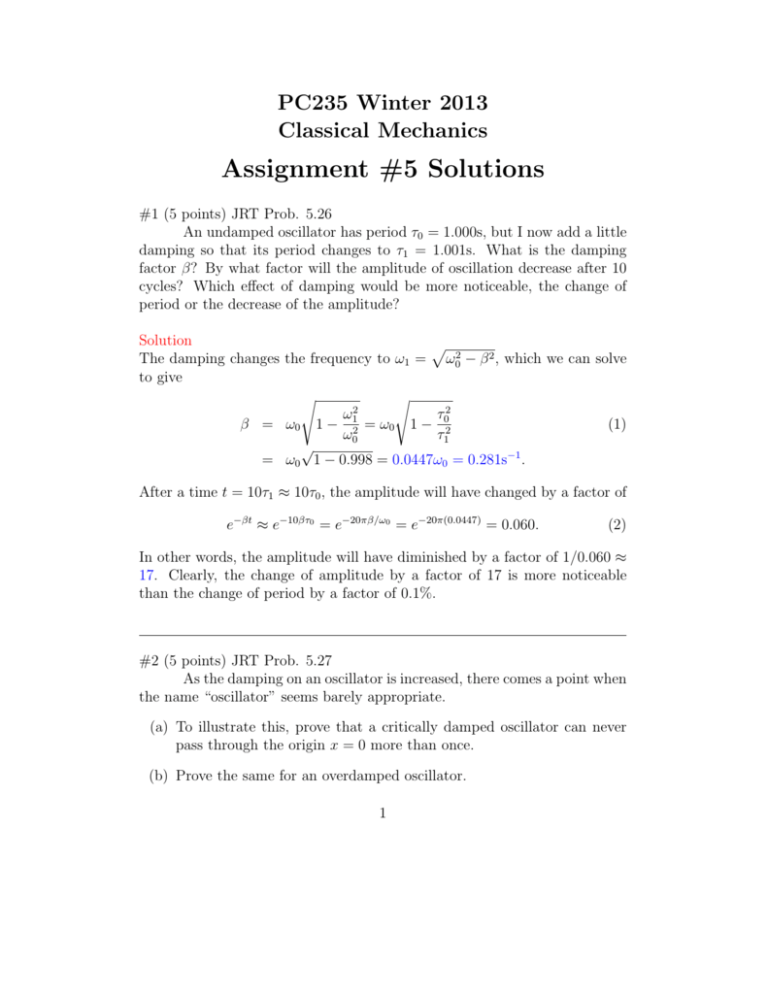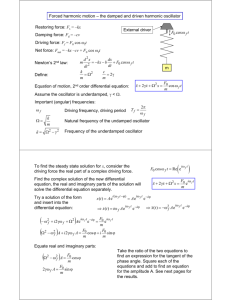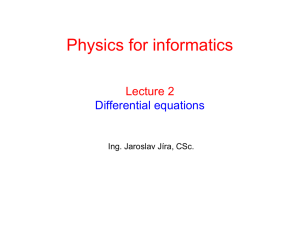Assignment #5 Solutions
advertisement

PC235 Winter 2013 Classical Mechanics Assignment #5 Solutions #1 (5 points) JRT Prob. 5.26 An undamped oscillator has period τ0 = 1.000s, but I now add a little damping so that its period changes to τ1 = 1.001s. What is the damping factor β? By what factor will the amplitude of oscillation decrease after 10 cycles? Which effect of damping would be more noticeable, the change of period or the decrease of the amplitude? Solution p The damping changes the frequency to ω1 = ω02 − β 2 , which we can solve to give s s ω12 τ2 (1) β = ω0 1 − 2 = ω0 1 − 02 ω0 τ1 √ = ω0 1 − 0.998 = 0.0447ω0 = 0.281s−1 . After a time t = 10τ1 ≈ 10τ0 , the amplitude will have changed by a factor of e−βt ≈ e−10βτ0 = e−20πβ/ω0 = e−20π(0.0447) = 0.060. (2) In other words, the amplitude will have diminished by a factor of 1/0.060 ≈ 17. Clearly, the change of amplitude by a factor of 17 is more noticeable than the change of period by a factor of 0.1%. #2 (5 points) JRT Prob. 5.27 As the damping on an oscillator is increased, there comes a point when the name “oscillator” seems barely appropriate. (a) To illustrate this, prove that a critically damped oscillator can never pass through the origin x = 0 more than once. (b) Prove the same for an overdamped oscillator. 1 Solution (a) If the oscillator is critically damped, β = ω0 , and x(t) = e−βt (C1 +C2 t). This vanishes if and only if t = −C1 /C2 . Since C1 and C2 are constants, there is at most one such value for t (it may never vanish; for example if the motion starts at t = 0 and −C1 /C2 < 0). (b) If the oscillator is overdamped, β > ω0 and x(t) = e−βt (C1 eλt + C2 e−λt ) = e−(β−λ)t (C1 + C2 e−2λt ), (3) p where λ = β 2 − ω02 . This vanishes if and only if e−2λt = −C1 /C2 , and since e−2λt is a monotonic function (always decreasing), this happens at most once. #3 (5 points) JRT Prob. 5.32 Consider an underdamped oscillator (such as a mass on the end of a spring) that is released from rest at position x0 at time t = 0. (a) Find the position x(t) at later times in the form x(t) = eβt [B1 cos(ω1 t) + B2 sin(ω1 t)] . (4) That is, find B1 and B2 in terms of x0 . (b) Now show that if you let β approach the critical value ω0 , your solution automatically yields the critical solution. (c) Using appropriate graphing software, plot the solution for 0 ≤ t ≤ 20, with x0 = 1, ω0 = 1, and β = 0, 0.02, 0.1, 0.3, and 1. Solution (a) If we write x(t) in the suggested form, it is easy to see that x(0) = B1 and ẋ(0) = ω1 B2 − βB1 . Therefore, B1 = x0 and B2 = βx0 /ω1 , so that β −βt sin ω1 t . (5) cos ω1 t + x(t) = x0 e ω1 p (b) When β → ω0 , ω1 = ω02 − β 2 approaches zero. The cos ω1 t term thus approaches one. To deal with the (β/ω1 ) sin ω1 t term, we then make use of the limit 2 β sin ω1 t βt sin ω1 t = tsinc(0) = βt. (6) = lim ω →0 ω1 ω1 t 1 Therefore, the solution of part (a) becomes x(t) = x0 e−βt (1 + βt), (7) which is precisely the critically-damped solution satisfying the initial conditions (see eq. 6.34 in the class notes.) lim ω1 →0 1 0 0 x −1 0 x 1 5 10 t β=0.1 15 −1 0 20 1 1 0 0 −1 0 x x (c) The requested plots are shown below. 5 10 t β=1 15 20 5 10 t 15 20 −1 0 5 10 t β=0.3 15 20 5 10 t 15 20 x 1 0 −1 0 Fig. 1: Plots for question #3 #4 (5 points) JRT Prob. 5.44 Another interpretation of the Q of a resonance comes from the following: Consider the motion of a driven damped oscillator after any transients have died out, and suppose that it is being driven close to resonance, so you can set ω = ω0 . (a) Show that the oscillator’s total energy (kinetic plus potential) is E = 1 mω 2 A2 . 2 (b) Show that the energy ∆Edis dissipated during one cycle by the damping force Fdmp is 2πmβωA2 . 3 (c) Hence, show that Q is 2π times the ratio of ∆Edis . Solution (a) Since x = A cos(ωt − δ), the total energy is 1 1 1 1 E = mẋ2 + kx2 = mω 2 A2 cos2 (ωt − δ) + kA2 sin2 (ωt − δ). (8) 2 2 2 2 Because ω ≈ ω0 , we can replace k = mω02 with mω 2 , and then, with cos2 θ + sin2 θ = 1, we get the required E = 21 mω 2 A2 . (b) The rate at which the damping force dissipates energy is Fdmp v = bv 2 = 2mβv 2 . Therefore, the energy dissipated in one period is Z τ Z τ 2 2 2 2 bv = 2mβv dt = 2mβω A ∆Edis = sin2 (ωt − δ) dt. (9) 0 0 The integral evaluates to π/ω, and we are left with ∆Edis = 2πmβωA2 . (c) Combining the results of parts (a) and (b), we find that 1 mω 2 A2 ω0 Q E 2 = = , = 2 ∆Edis 2πmβωA 4πβ 2π (10) where we have again used ω = ω0 . Therefore, the ratio of total energy to energy lost per cycle is Q/2π. #5 (5 points) JRT Prob. 6.2 Repeat problem 6.1 but find the length L of a path on a cylinder of radius R, using cylindrical polar coordinates (ρ, φ, z). Assume that the path is specified in the form φ = φ(z). Solution Consider an infinitesimal section of path on the cylinder, in which φ increases by dφ and z increases by dz. This carries us a distance Rdφ around the cylinder and a distance dz up it. The distance ds along the path is therefore p p (11) ds = (Rdφ)2 + (dz)2 = R2 φ′ (z)2 + 1dz. 4 Therefore, the total path length is Z Z 2 ds = L= 1 2 1 p R2 φ′ (z)2 + 1dz. (12) #6 (10 points) JRT Prob. 6.4 A ray of light travels from point P1 in a medium of refractive index n1 to a point P2 in a medium of index n2 , by way of the point Q on the plane interface between the two media. Show that Fermat’s principle implies that, on the actual path followed, Q lies in the same vertical plane as P1 and P2 and obeys Snell’s law, that n1 sin θ1 = n2 sin θ2 . Solution The lengths of the paths P1 Q and QP2 are q q 2 2 2 P1 Q = x + h1 + z and QP2 = (x2 − x)2 + h22 + z 2 . (13) The time for light to traverse each path is the path length divided by the local speed of light, v = c/n. Thus, the total time is q q 1 2 2 2 2 2 2 (14) n1 x + h1 + z + n2 (x2 − x) + h2 + z . t= c To find where this is minimum, we must set first of these conditions gives ∂t 1 = ∂z c n1 z ∂t ∂z and n2 z ∂t ∂x equal to zero. The p +p (x2 − x)2 + h22 + z 2 x2 + h21 + z 2 ! = 0, (15) which is satisfied only when z = 0. That is, Fermat’s principle requires that Q lie in the plane containing P1 and P2 and containing the interface. The second condition gives ! ∂t n1 x 1 1 n2 (x2 − x) p p = (n1 sin θ1 − n2 sin θ2 ) = 0, = + ∂x c c (x2 − x)2 + h22 + z 2 x2 + h21 + z 2 (16) 5 which is satisfied only if n1 sin θ1 = n2 sin θ2 ; this is Snell’s law. #7 (5 points) JRT Prob. 6.12 Rx p Show that the path y = y(x) for which the integral x12 x 1 − y ′2 dx is stationary is an arcsinh function. Solution p The integrand is f (y, y ′ , x) = x 1 − y ′2 . Since this is independent of y, ∂f /∂y = 0, p and the E-L equation implies simply that ∂f /∂y ′ is a √ constant; that is, xy ′ / 1 − y ′2 = k. This can be rearranged to give y ′ = k/ x2 + k 2 , which integrates to give y = k sinh−1 (x/k) + C, where C is a constant of integration (to perform the integral, make the substitution x/k = sinh u). A more pleasing representation of this path is found by rearranging to find x = k sinh y−C . k (17) #8 (10 points) JRT Prob. 6.23 An aircraft whose airspeed is v0 has to fly from town O (at the origin) to town P , which is a distance D due east. There is a steady gentle wind shear, such that vwind = V yx, where x and y are measured east and north, respectively. Find the path y = y(x), which the plane should follow to minimize its flight time, as follows: (a) Find the plane’s ground speed in terms of v0 , V, φ (the angle by which the plane heads to the north of east), and the plane’s position. RD (b) Write down the time of flight as an integral of the form 0 f dx. Show that if we assume that y ′ and φ both remain small (as is certainly the case if the wind speed is a small fraction of the plane’s airspeed), then the integrand f takes the approximate form f = (1 + y ′2 /2)/(1 + ky) (times an uninteresting constant), where k = V /v0 . (c) Write down the Euler-Lagrange equation that determines the best path. To solve it, make the intelligent guess that y(x) = λx(D − x), which passes through the two towns. Show that it satisfies the E-L equation, 6 √ provided that λ = ( 4 + 2k 2 D2 − 2)/(kD2 ). How far north does this path take the plane, if D = 2000 miles, v0 = 500 mph, and the wind shear is V = 0.5 mph/mile? How much time does the plane save by following this path? Solution (a) If the plane is at position (x, y) and is heading at an angle φ north of east, its velocity relative to the air is (v0 cos φ, v0 sin φ), while the wind’s velocity is (V y, 0). The plane’s velocity relative to the ground is the sum of these two vectors, so its ground speed is p v = (v0 cos φ + V y)2 + (v0 sin φ)2 (18) q v02 + 2v0 V y cos φ + V 2 y 2 (19) = ≈ v0 + V y = v0 (1 + ky), (20) where we have made the approximation cos θ ≈ 1 (a “zeroth-order” approximation), and where k = V /v0 . (b) The time of flight is p Z D Z 1 + 12 y ′2 1 + y ′2 dx 1 D t= ≈ dx = f dx, v v0 0 0 0 0 v0 (1 + ky) (21) where we used the binomial approximation in the numerator (assuming y ′ is small) and where f = (1 + y ′2 /2)/(1 + ky). Z P ds = v Z D (c) A bit of algebra shows that the E-L equation is 1 y ′′ (1 + ky) − ky ′2 + k = 0. 2 (22) We don’t possess the skills necessary to solve this nonlinear 2nd-order differential equation, so we will substitute the proposed guess, y = λx(D − x), which results in kD2 λ2 + 4λ − 2k = 0, (23) √ which has the solution λ = ( 4 + 2k 2 D2 −2)/(kD2 ) (the other solution is negative, which makes no physical sense since the wind direction is 7 always opposing the desired direction of travel for y < 0). The maximum displacement to the north is ymax = λD2 /4 = 366 miles. If we solve the integral in part (b), we find for the time of flight t = 3.556 hours. The flight time along the direct path is 4 hours (there’s no wind on the x-axis), so the time saved is 0.444 hours, or 27 minutes. #9 (10 Bonus points) JRT Prob. 5.53 An oscillator is driven by the periodic force shown in the figure below, which has period τ = 2. (a) Find the long-term motion x(t), assuming the following parameters: natural period τ0 = 2 (that is, ω0 = π), damping parameter β = 0.1, and maximum drive strength fmax = 1. Find the coefficients in the Fourier series for x(t) and plot the sum of the first four terms in the series for 0 ≤ t ≤ 6. (b) Repeat, except with natural period equal to 3. Fig. 2: Periodic driving force of question #9 Solution Because the function f (t) is even, all of the Fourier coefficients bm are zero. We need only to find the coefficients am . From eq. (6.68) from the class notes, Z 1 τ /2 fmax a0 = (24) f (t)dt = τ −τ /2 2 while for m ≥ 1 (and noticing that the portion of the integrand to the left and to the right of t = 0 contribute equally to the integral), Z Z 1 4 τ /2 cos(mωt)f (t) dt = 2fmax cos(mωt)(1 − t) dt. (25) am = τ 0 0 8 This integral is evaluated using integration by parts, yielding 0 m even 2fmax 1 . am = − [cos(mπt]0 = 4fmax 2 m odd (mπ) (mπ)2 (26) From eqns. (6.71-6.72) of the class notes, we know that the motion of the oscillator is described by x(t) = ∞ X n=0 An cos(nωt − δn ) (27) with An = p fn (ω02 − n2 ω 2 )2 + 4β 2 n2 ω 2 , δn = tan −1 2βnω ω02 − n2 ω 2 . (28) (for the case n = 0 this just becomes A0 = 2ω1 2 and δ0 = 0.) From the figure 0 illustrating the driving force, we see that the driving frequency ω = 2π/τ = π, where τ is the period of the driving force. (a) For τ0 = 2, we have ω0 = π. For β = 0.1 and fmax = 1, this means that the first four coefficients An (n = 0, 1, 2, 3) are 0.0507, 0.6450, 0, and 0.0006. Note that the term A1 dominates the sum, because this term is on resonance with the natural frequency of the oscillator. The oscillations are plotted below. (b) For τ0 = 3, we have ω0 = 2π/3, and the first four coefficients An (n = 0, 1, 2, 3) are 0.1140, 0.0734, 0, and 0.0005. In this case, note that the constant term A0 is the largest, meaning that the oscillations are significantly biased toward positive x. The oscillations are plotted below. 9 0.8 0.6 0.4 x(t) 0.2 0 −0.2 −0.4 −0.6 0 1 2 3 time 4 5 6 Fig. 3: Question #11 - motion of the oscillator. Blue: τ0 = 2. Green: τ0 = 3. 10






